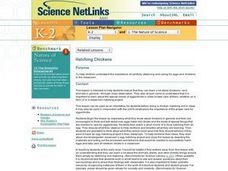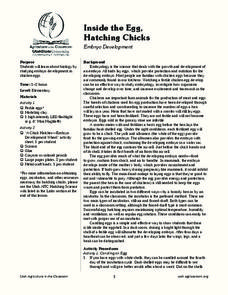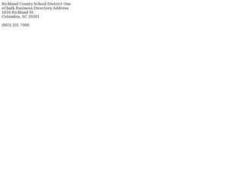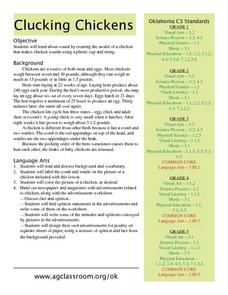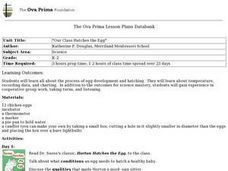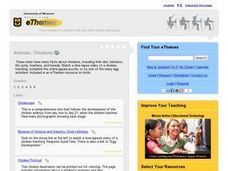Curated OER
Hatching Chickens
Young scholars observe and care for eggs and chickens. In this life cycles lesson, students recall facts about chickens and how they hatch. Young scholars read the article Hatching Eggs in the Classroom and observe the life cycle of the...
Curated OER
Hatching Egg Lesson
What a great way to introduce life cycles in your classroom! Kindergartners learn about chickens using visual aids, vocabulary lists, and more. If possible, you can have your class watch the process up close and personal by bringing in...
Curated OER
Inside the Egg, Hatching Chickens
Young scholars explore how an egg becomes fertilized. For this biology lesson, students "candle" a variety of eggs in order to determine which ones have been fertilized and which ones haven't. Student use paper plates to create a graphic...
Curated OER
Inside the Egg, Hatching Chickens
Students conduct an egg candling activity to show the life inside a fertile egg. Students discuss the needs the egg has of the hen, as well as similarities and differences between plants and animals. Students complete a life cycle wheel...
Curated OER
Hatched From An Egg
Students discover how animals are born/hatched. In this life science lesson, students listen to a book entitled Chickens Aren't The Only Ones, and discuss animals that are hatched or born. Students receive a picture of an animal,...
Curated OER
EGG-STRA, EGG-STRA LEARN ALL ABOUT IT
Students explore how animals produce young by watching age-appropriate videos on the subject. They watch as chicken eggs either hatch or not in an incubator.
Curated OER
Clucking Chickens
A comb, wattle, and beak are three characteristics that describe a chicken. Your class can explore the life of a chicken through reading, art, movement, and music. Using a plastic cup and string, they'll create a pretend chicken that...
Curated OER
"Our Class Hatches the Egg"
Students research all about the process of egg development and hatching. They access about temperature, recording data, and charting. In addition to the outcomes for science mastery, students gain experience in cooperative group work,...
Curated OER
How Fragile Is an Egg?
Students design a "container" for his/her egg to determine whether the egg remain intact when dropped from a predetermined height.
Curated OER
Children's Literature Across the Curriculum Ideas: Chickens Aren't the Only Ones
Students read Chickens Aren't the Only Ones by Ruth Heller. They complete a variety of cross-curricular activities surrounding the study of animals that come from eggs. Included are reading, art, math, science, writing, social studies,...
Curated OER
Animals: Chickens
Students use the Internet to discover information about chickens. They examine their diet, behavior and life cycle.
Curated OER
Incubation and Embryology
Students examine chickens, eggs and hatching eggs through this series of lessons.
Curated OER
Life Comes in Cycles
Kids are fascinated by chickens and their eggs. Here is a learning exercise has young learners take a look at the four stages in a chicken's life cycle. They have four cycles to organize: egg, chick, young bird, and adult. They have to...
Curated OER
Hatching Chicks
Students create hatching chickens using plastic Easter eggs, yellow cottonballs, small plastic eyes, and orange construction paper in this fun and quick Easter Art lesson for the elementary classroom. A list of recommended craft books...
Curated OER
Which Came First, the Chicken or the Egg?
In this worksheet, students answer questions regarding the function of an egg.
Curated OER
Hatching Chicks to Agriculture - Where does the feed come from?
Second graders examine the types of grain that goes into feed for chickens. They study other grain crops grown in Kansas and the foods that are made from them.
Curated OER
What's Hatching in Kindergarten?
Students identify oviparous animals. They brainstorm a list of animals that lay eggs, read "Chickens Aren't The Only Ones" by Ruth Heller and then add to the list. Students complete a booklet that shows an egg and an oviparous animal.
Curated OER
Egg Toss
This cross curricular instructional activity involves eggs. Students read about eggs. A counting game involving an egg carton and ping pong balls (eggs) is played as students toss balls into numbered egg carton cups and adding their...
Curated OER
Eggs
Students know the following parts of an egg as the yolk, white, shell, membrane, chalaza, and air sac. They also sequence the growth of the chick in the egg. An egg is broken and students touch, smell and see it. They locate the six...
Curated OER
How Hot is Too Hot?
Fifth graders use the scientific method to conduct experiments on the temperature effects on organisms. In this temperature effects on organisms lesson plan, 5th graders observe and record the hatching or the developing of organisms into...
Curated OER
Get Cracking
Students compare the life cycle of an animal hatched from an egg with one born from its mother's womb. The lesson focuses on dinosaur eggs. They create dinosaur eggs from balloons and papier mache.
Curated OER
Embryo Development
Students observe the development of a chicken embryo. In this biology lesson, students compare and contrast the development of human and chick embryo. They make a chart and explain their findings to the class.
Curated OER
Comparative Embryology Using Japanese Medaka Fish
Students conduct an experiment to control the breeding of Japanese Medaka fish. They collect the fertilized eggs and view and record the fish's embryological development daily to compare the stages to human development.
Curated OER
Are You Aware?
Bring the five senses to life with a fun science experiment! Kindergartners and first graders read an explanation of the five senses, then identify which items Sophia can sense if she is blindfolded. A science explanation at the bottom...
